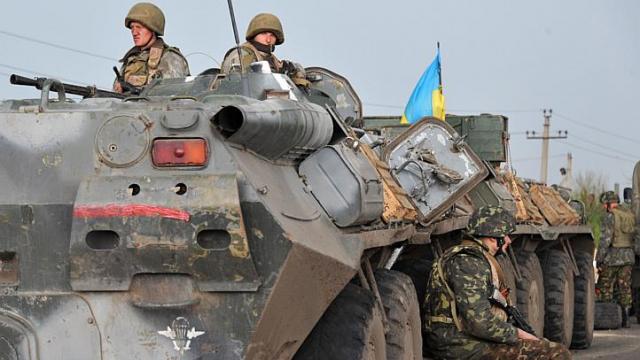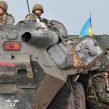
Political Implications of the Russia (‘Donetsk/Luhansk’)–Ukraine Armistice
Publication: Eurasia Daily Monitor Volume: 11 Issue: 168
By:

The shape of any political settlement will depend on whether Russian troops and paramilitary personnel with their weaponry are evacuated from what is legally Ukraine’s territory, or remain deployed there. Point 9 of the September 20 memorandum is unfulfillable as formulated (and it is hard to imagine a more effective formulation of it), which is why Russia has agreed to have it included in the document. Given Russia’s transfers of personnel and arms to Donetsk-Luhansk-flagged forces, it becomes particularly difficult in practice to disentangle “local” from “foreign” (originating in Russia) in those forces (see accompanying article).
Moscow and the Donetsk-Luhansk “republics” will undoubtedly argue that the forces there are “local.” Russia refuses to acknowledge its force deployments on Ukraine’s territory. Eventually, Moscow may adjust its stance and repatriate some token numbers of personnel and weaponry, but leave the bulk in place, demand the easing or lifting of Western sanctions in return for such Russian tokenism, and expect some Western policy makers to reward such “de-escalation.”
The September 20 document had been intended to cover military issues, without directly addressing the Donetsk and Luhansk “republics’ ” political status or their relationship to Ukraine’s central government. However, some political implications are clearly apparent.
Without naming the “conflict parties” outright, the document clearly implies that Ukraine versus the Donetsk-Luhansk forces are the parties to the conflict, while positioning the actual aggressor Russia de facto as an intermediary.
For the first time, the Donetsk-Luhansk “representatives” are now referenced within the text of the document with that title (albeit not by name), as well as signing the document alongside the representatives of Ukraine, Russia and the Organization for Security and Cooperation in Europe (OSCE). Thus, Moscow’s proxies have been empowered as “representatives” to continue the secession process de facto (osce.org, accessed September 20, 24).
The terms “bilateral” and “the sides” in the document again imply two sides within Ukraine, rather than Russia versus Ukraine, thus vindicating Russia’s claim that the conflict is internal to Ukraine, and absolving Russia of its responsibility as conflict-initiator. The document uses in one instance the term “certain districts of the Donetsk and Luhansk provinces” (as did the September 5 protocol and Ukraine’s September 16 law). However, Donetsk “prime minister” Aleksandr Zakharchenko and Luhansk “republic head” Igor Plotnitsky declared after the signing that their “independence has essentially been recognized” (Interfax, September 20).
Political status issues and the Donetsk-Luhansk relationship to Kyiv are matters to be discussed at subsequent rounds. Russia wants the Ukrainian government to be represented by official negotiators, instead of former president Leonid Kuchma in his private capacity. In that case, Moscow will undoubtedly insist that its protégés also be given some upgraded, quasi-official status in the negotiations.
Russia’s partition of Ukraine’s Donetsk and Luhansk provinces is acquiring increasingly clear contours after this latest negotiating round, creating an impregnable base for its proxies to negotiate with Kyiv under Russia’s military protection.
The whole procedure of these negotiations seems designed to relegate Ukraine into an “eastern” zone, outside the Europe of Ukrainian aspirations. For reasons unclear and unexplained, the negotiations are located in Belarus, which is seen in the West as something close to Russian turf. For similar considerations, the West had relegated the negotiations on the Armenia-Azerbaijan conflict to be conducted in Belarus, two decades ago (that forum is still called the “Minsk Group” down to the present day). Selecting the same location for negotiations affecting Ukraine amounts to an acknowledgment of the paramountcy of Russian interests over those of the West in Ukraine.
Ukraine is isolated in this negotiating format opposite Russia, its two proxies, and Russia’s blocking powers in the OSCE. This is in no sense an international format or process. The Western powers had variously participated in the Geneva format (April), Normandy format (June) and Berlin format (July), which, for all their inadequacies, and even when marginalizing Ukraine, at least did not isolate Ukraine. But the West is entirely out of the equation in the current Minsk process, as this process deserves to be named.
Western powers are reluctant to face Russia across the negotiating table while negotiations can still make a difference. Instead, they are leaving Ukraine to face Russia directly in the negotiations. Most likely, the Western powers will establish some international format, but only after the Minsk process will have advanced far enough to conserve the conflict on Russian terms and cement the positions of the Donetsk and Luhansk “republics.” At that point, an international format with Western participation will implicitly ratify (“freeze”) Russia’s faits accomplis on the ground inside Ukraine. This procedure will conform to the patterns set in the cases of Transnistria (1992 to date), Abkhazia and South Ossetia (1992–2008 and, slightly revised/updated, from 2008 to date). Western powers do not even propose to raise the annexation of Crimea as a topic of negotiations with Russia.
By keeping away from the current phases of negotiations, the Western powers are acquiescing in Russia’s implantation of the biggest conserved conflict in Europe. Come winter with an economic crisis in Ukraine, however, this conflict may spread farther afield, rather than being simply conserved.




